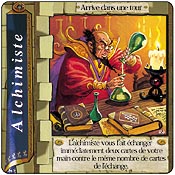The first one is the born of the idea. This, as said in a precedent post, should come from an already played game.
The second one is the devolopment of this idea.
Usually there are more ideas than games. And that's fine because should be impossible to fit all the ideas in a good game.
I use two different medias to annotate an idea: an excercise book and a word processor.
I prefer a big excercise book with small squares. Small squares are useful to draw some draft schema.
As word processor I'm using Google Doc mainly because I can easly share my ideas to playtesters or friends.
I have to admit that I tend to share a document mainly for the rules instead of the ideas....
The idea so written will never remain the same one. But writing the idea is a way to focus on the idea itself.
The idea is the source for the second phase.
The second phase is more long and harder to achive. Infact if this second phase will successfully end I have a game that can be played. This is what I called the development of the idea. It should be also called prototyping.
It is nice to note that in the software engineering field the prototyping is one of the phase on the software production lifecyle. So there is a good parallel between making computer programs and making a boardgame. We can assume the during this phase the game is in alfa testing (it is a software term).
The main task during prototyping is the test.
Usually I iterate through the following steps:
1. I prepare or modify a prototype
2. I test it for myself
3. The game was not good? I quit! I consider this idea not good enough!
4. Something to change? Come back to point 1.
5. Is the development of the idea good enough?
6. I prepare a better prototype.
7. I test it with real players. I also send the prototype to players who are not from my gaming group
8. There is some good feedback so that it can be changes somethin? I come back to point 1.
9. If I am really soddisfied I can consider the development phase finished.
There are a lot to discuss about these points, and I will in future posts.
What I want to highlight now is that there are 2 loops on this phase.
The first is on point 3 and the second on point 8. Both let the process go back to point 1.
But point 1. is to prepare a new prototype, with some relevant changes in order to test these changes.
Sometimes you don't really need to change the prototype, but only some rules (if you consider rules part of the prototype, you can say that each time you change a rule, you just change the prototype!).
When I first start with a prototype I try to quick create one. Usually I
 re-use pieces from other games (there are some boxes on my collection almost empty :-). I have some "preferred" pieces. For instance as score track I tend to use the one from Carcassonne! If I need some colored cards I use them from my Il Principe or I uses some very common Land Cards from Magic the Gathering (they are freely provided by my friend Stefano Rampazzo who owns the boardgame shop Tempus Fugit).
re-use pieces from other games (there are some boxes on my collection almost empty :-). I have some "preferred" pieces. For instance as score track I tend to use the one from Carcassonne! If I need some colored cards I use them from my Il Principe or I uses some very common Land Cards from Magic the Gathering (they are freely provided by my friend Stefano Rampazzo who owns the boardgame shop Tempus Fugit).Because of the proto should be transformed several times, and maybe it will be dismissed because of the idea wasn't good enough, it is a waste of time to prepare a very detailed prototype.
Moreover in the first steps I will be the only one who test the game: I have my ideas in my mind (and in my excercise book) so I should survive to a collage of pieces as prototype!
In point 6., before to try the game with real players, I try to have a bett
 er proto. This means trying to have not an abstract game, but with a theme (maybe a not definitive one). Anyway I try to focus to have a pretty good playable proto.
er proto. This means trying to have not an abstract game, but with a theme (maybe a not definitive one). Anyway I try to focus to have a pretty good playable proto.This is important, in my opinion, because I want to be sure that problems that will come out can be assign to the game mechanics itself and not to a poor rappresentation of the game.
 Again Google Images is coming in help. You just need to search for a "sheep picture" in order to have several good symbols for your Catan like prototype.
Again Google Images is coming in help. You just need to search for a "sheep picture" in order to have several good symbols for your Catan like prototype.Sometime I re-uses artwork from other games (not only mine). I remember I tested Fantasy Pub before the publishing to the Bruno Faidutti's gathering many years ago! And I used some pictures from a Bruno's game! He came close to the table and said smiling: "I think I know this wizard!".
So the proto is improved in two different ways:
- the changes of mechanics and rules that must be naturally followed by the change of proto;
- the improvement of the pictures, symbols, components of the proto itself.
No comments:
Post a Comment